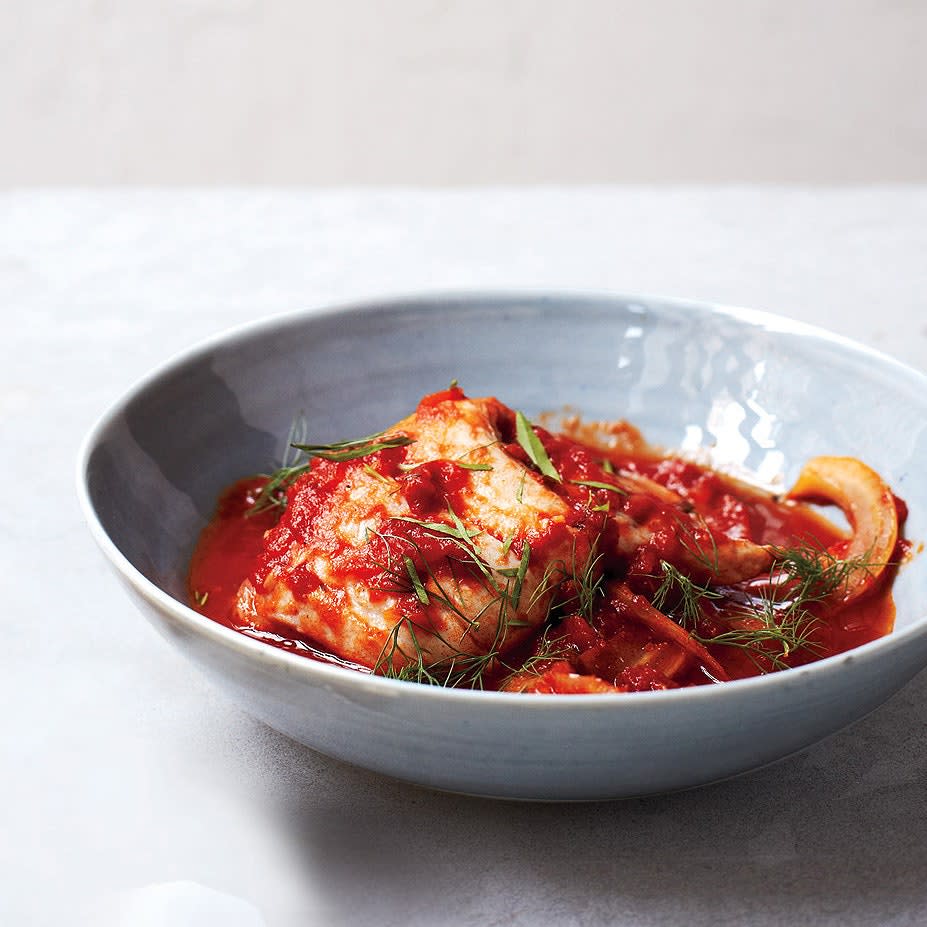5 Ways to Amp Up Jarred Pasta Sauce
Awhile back, my fellow Epi Test Kitchen bud Anna Stockwell was making batches and batches of Parmigiana—with chicken, eggplant, veal, and more, and the Epi staff was pleasantly surprised at how much we enjoyed the sauce. Why? It came from a jar.
We're big fans of anything that saves time on weeknight dinners, and jarred pasta sauce is certainly that.
So, we decided to put some jars to the test—like we've done with butter and peanut butter before—to figure out the best sauce to turn to when a four-hour marinara just isn't possible.
We all had our favorites. I put together a list of 10 sauces to try, ranging from Rao's, a staff favorite, to the cult classic Trader Joe's brand to the actually-classic Classico. But dipping into the sauces, even warmed, even spooned on bread, was not successful. Straight from the jar, most were bland, some tasted strangely chemical, and nearly all were disappointing.
The overwhelming result of our taste test was this advice: don't eat pasta sauce straight from the jar.
For this month's Sunday Stash, we're making a big batch of my super-simple tomato sauce, freezing it in small quantities, and using it to make meals all month long.
But that doesn't mean we'd ban jarred sauce from our pantry. Jarred sauce can save you time for a quick weeknight meal, and make lasagna, meatballs, or Parmigiana come together beautifully. You just have follow a few steps before you use it.
1. Heat It
Never pour jarred sauce directly onto pasta and call it a day! At a minimum, heat the pasta sauce in a separate pot. Warming the sauce will awaken the spices and encourage the sugars to caramelize as the aromas are released. (You want your food to smell good, right?!)
Stuffed Shells with Marinara
Bon AppétitPalizzi Social Club; Philadelphia
2. Flavor It
Even better, season it! Taste the sauce once it's warm and add some seasoning. Maybe it needs a touch of salt, red pepper flakes, or some fresh garlic to liven it up. You could add dried or fresh herbs too: oregano, basil, thyme, tarragon, parsley—they're all great!
Want to go next level? Toss in some chopped anchovies (or anchovy salt), olives, or some lemon zest and/or juice. These things all add layers of flavor and give the sauce either depth or brightness, depending on the ingredient.
Detroit-Style Pizza
3. Cook It
If you want to get a little creative, treat that jarred sauce just like you would a can of whole or crushed tomatoes. Start by sautéing garlic and onion, then add some wine and let it deglaze the pan, releasing any (flavorful) bits stuck to the bottom. Stir in the sauce and taste. Reduce the jarred sauce a bit to really concentrate that flavor—you can even let it dry out in the pan until it's really caramelized (and then thin it back out with pasta cooking water) to really concentrate the flavor and give the sauce body. Give it a taste? Pour in a splash of vinegar, or a spoonful of sugar to balance the flavor if necessary. Finally, toss in some fresh herbs, if you have them, to finish it off.
Flounder Poached in Fennel-Tomato Sauce
Bon Appétit
4. Enrich It
Want to immediately transform that sauce into a creamy, rich texture? Stir in a few spoonfuls of heavy cream. Or finish the sauce with butter, à la the much-loved Marcella Hazan method. You could also fold a few handfuls of grated Parmesan or other hard cheese into the simmering sauce. Got goat cheese on hand? Stirring some in makes regular marinara into a creamy, tangy pasta sauce that's great with whatever vegetables you have on hand.
No dairy around? A hefty drizzle of olive oil stirred in off the heat is also a great move.
And if you're feeling really spunky, add some meaty richness to that sauce: crisp some bacon or brown sliced sausages or ground meat. For some veggie richness, sauté mushrooms or caramelize fennel in plenty of olive oil. If you're drinking wine, you can pour in a bit to deglaze the pan as you cook them. Add the jarred sauce over the cooked meat or vegetables, stir well, and simmer it all together for several minutes.
Penne alla Vodka
5. Bake It
The Epi staff's favorite way to use jarred pasta sauce is baking it, which lets those sugars really caramelize and the flavors cook down and deepen, as well as take on some of the flavor of the foods the sauce is cooked with. Use it for Parmigiana, lasagna, meatballs, baked ziti, or any other baked tomato sauce dish.
Sausage and Ricotta Baked Cannelloni
Bon Appétit
Originally Appeared on Epicurious







